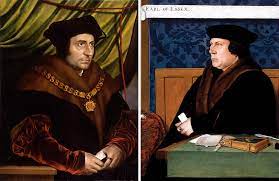Hilary Mantel, English novelist died last week at the age of 70. Her fame – or infamy, depending on one’s perspective – rests largely upon her ‘Wolf Hall’ sagas of the Reformation period, made even more popular by their being produced as a lush film series by the BBC back in 2009. According to reviews, linked to below – full disclosure, I have neither read the books nor watched the adaptation – the series was heavy on the fiction, at least as far as the characters were concerned. Thomas More is turned into into a sexually-repressed milquetoast neurotic, while the contemptible Thomas Cromwell becomes a strong, capable, even noble hero, who, by the bye, made the ladies swoon.
Both were complex characters, as are all saints and sinners in this pilgrimage of life, but the real history is that More died a noble martyr, ‘the king’s good servant, but God’s first’. Cromwell, on the other hand, Henry’s obsequious henchman, after enriching himself at the expense of others, fell out of the king’s whimsical and tyrannical good graces when he arranged a failed marriage to Anne of Cleves. He went to the scaffold blubbering for the king’s mercy, which Cromwell had blithely denied others. Cromwell was also the one primarily responsible for looting and pillaging every single monastery in the British realm, condemning to death untold numbers of innocent men consecrated to God.
Yes, Robert Bolt’s play A Man for All Seasons, takes some liberties, but it does the justice of keeping the moral trajectory of the characters intact, which really is the ultimate point of history – to learn from those who came before us, so we may avoid their errors in the present, and do better for the future, as we all pilgrimage towards the eschaton and the consummation of all time. We may lament that too many of our current crop of politicians haven’t learned much, far more Cromwellian than Morean.
The reader may peruse a series of critical reviews in First Things. Patricia Snow cogently argues that the work of projection of the author’s own fractious and troubled life. While Mark Movesian posits the author’s political agenda, decidedly liberal, and on board with the progressive and iconoclastic climate. Hence, her being feted with two Booker prizes. Finally, Richard Rex’s insightful piece argues that it is More who really carries the plot, as he is by far the more intriguing and powerful figure; the more the author tries to diminish him, the more More grows in the background by the sheer ridiculousness of the inversion. Their respective portraits by Hans Holbein show the difference between the two Thomases in their contemporary faces. There is a reason More’s painting is by far the more famous and treasured than Cromwell’s. As I quoted Orwell’s quip recently, we get the face the deserve at fifty, which must be taken cum grano salis, but was not far from the age those portraits were painted.
Fruitful also would be a perusal of Hilaire Belloc’s insightful take on these two characters of the Reformation, along with many others, from a more balanced, true and Catholic perspective.
There are any number of sources for deeper reading, older and newer, and the reader may reach out to me personally for suggestions.
Who knows? Perhaps Thomas More interceded for Ms. Mantel in those final moments. He always did take attacks on his character in good stride, laughing them off, even if he would defend the Church with gusto. What we do know is that the author of this historical fabrication knows the truth now, and we may hope and pray that in some way she availed herself of God’s infinite mercy. +










